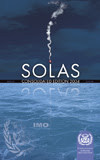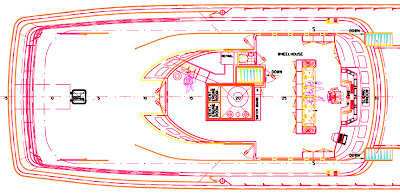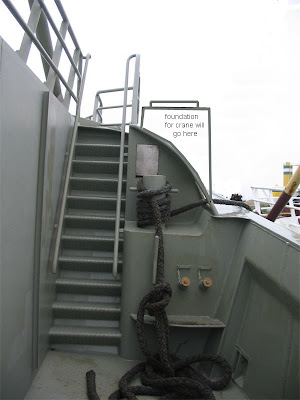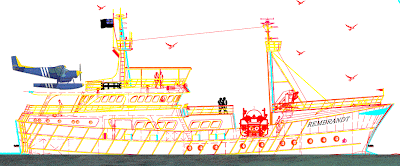Friday, April 13, 2007
Moving this blog !
This blog is hosted on a free service by Blogspot.com. Nice to get started but it lacked the flexibility I needed so we moved it to our own server and run it under a more flexible blog software called WordPress.
Please visit www.expeditionyacht.org from now on.
All content has been moved over there as well.
Thanks.
Thorwald Westmaas
blogger/project engineer
Thursday, April 12, 2007
Fire protection
 I said it before, where would I be without the Internet? Here we are in Panama, while a maritime hub, not exactly the center of maritime technology. The Panama Canal, while impressive and very smartly designed is over 90 years old and that's about the last time anything big happened on the local maritime scene.
I said it before, where would I be without the Internet? Here we are in Panama, while a maritime hub, not exactly the center of maritime technology. The Panama Canal, while impressive and very smartly designed is over 90 years old and that's about the last time anything big happened on the local maritime scene.So, getting info on what we need to make our project happen involves many hours of Internet surfing.
While surfing, I learned I would need a sprinker system in the guest accommodations. I had hoped to use the FirePro system but is not allowed for use in accommodation spaces as it creates a fine white mist which would not help guests to find their way to the exit in case of a fire. Too bad! It's a great concept (see other article in this section). But sprinklers make everything very wet. Many times, they do more damage than the fire itself! But, so I learned, there's an alternative. Water mist systems. They use about 70% less water, work more efficient, assure less smoke damage, require smaller piping and are environmentally friend: they use water after all.
 So far I've found only two companies that manufactures these systems. A finish one, Marioff, seems to be the major manufacturer and they have a very informative website. Check out Marioff's Hi-Fog system. Can you believe they even offer gold-plated sprinklers, especially made for use in mega yachts?
So far I've found only two companies that manufactures these systems. A finish one, Marioff, seems to be the major manufacturer and they have a very informative website. Check out Marioff's Hi-Fog system. Can you believe they even offer gold-plated sprinklers, especially made for use in mega yachts?A US-company, Fike Corporation also has a water mist fire protection system but I'm not sure yet if it meets class requirements. While they seem to serve the marine industry, there's no referral to type approval of their micro mist system.
And I ran into a German company, Fogtec that also manufactures water mist applications for marine use. Also a very informative site. Do check out their water mist history section. You can even watch videos of their product in operation! Those guys know how to use the Internet to inform their prospective clients. Sehr gut !
The following links also provide useful information about the history and use of water mist systems:
- water mist fire systems for shipboard use
(somewhat dated but very informative with comparativeinfo) - High pressure water mist fire protection off-shore
- Water mist: old method, new technology
 My only concern so far is that these systems are expensive or so I am told. At least they look expensive :-). But remember, we're not using the gold-plated ones.
My only concern so far is that these systems are expensive or so I am told. At least they look expensive :-). But remember, we're not using the gold-plated ones.
I wonder if there are alternatives for passenger spaces that are also SOLAS approved. Still surfing and e-mailing to find that out.
Drawings outsourced to China
 years to our ship's designer, Herman Jansen BV in the Netherland had AutoCAD drawing of newer ships that used the same hull.
years to our ship's designer, Herman Jansen BV in the Netherland had AutoCAD drawing of newer ships that used the same hull.However, the inside of the vessel like engine room, piping diagrams, and lots and lots of details were not available in AutoCAD. So, we just contracted a Chinese company to convert the most important of these drawings into AutoCAD to help us with the conversion and be able to provide precise and updated plans to meet future regulatory compliance.
Where would we be without the Internet ? Thanks Al Gore ! :-)
Classification & SOLAS
 You will see a lot of yachts, even the very big ones (check out yachtworld.com), have space for only 12 guests. This is not done because the owner has few friends to take along. It's done to avoid more stringent safety requirements. Once a vessel makes an international voyage with more than 12 passengers, it becomes subject to SOLAS regulation and is considered a passenger vessel even if it is in use as a private yacht. The SOLAS Convention in its successive forms is generally regarded as the most important of all international treaties concerning the safety of merchant ships. The first version was adopted in 1914, in response to the Titanic disaster, the second in 1929, the third in 1948, and the fourth in 1960.
You will see a lot of yachts, even the very big ones (check out yachtworld.com), have space for only 12 guests. This is not done because the owner has few friends to take along. It's done to avoid more stringent safety requirements. Once a vessel makes an international voyage with more than 12 passengers, it becomes subject to SOLAS regulation and is considered a passenger vessel even if it is in use as a private yacht. The SOLAS Convention in its successive forms is generally regarded as the most important of all international treaties concerning the safety of merchant ships. The first version was adopted in 1914, in response to the Titanic disaster, the second in 1929, the third in 1948, and the fourth in 1960.Passenger vessels are subject to very extensive safety regulations in regards to fire safety, navigation equipment, live saving equipment and more.
When we started asking around, many people recommended us not to design for more than 12 passengers because of the extra cost involved with regulatory compliance. But with several owners, we felt that 12 passengers isn't very much and this limitation would limited the usability of our yacht considerably (and its resale value :-) ). Moreover, when we started to look into the SOLAS requirements, it turned out that they were very much common sense and something we'd like to build into our yacht regardless of the requirements.
 For instance, what's wrong with using fire-resistant walls between cabins and have a fire detection and protecion system that works automatically and uses an environmentally friendly product? Or use enough watertight doors so hitting the rocks won't sink the ship? Or have enough live vests and life rafts on each side of the ship with a release system that even grandma can use?
For instance, what's wrong with using fire-resistant walls between cabins and have a fire detection and protecion system that works automatically and uses an environmentally friendly product? Or use enough watertight doors so hitting the rocks won't sink the ship? Or have enough live vests and life rafts on each side of the ship with a release system that even grandma can use?So, we'll just stick to SOLAS and be safe! I'd hard to understand why anybody spending a few million on a serious yacht would not make the extra investment in safety but I guess they haven't heard the line 'if you think safety is expensive, try an accident'.
SOLAS compliance is enfored by the flag state, in our case it will be Panama. We plan to hire ABS (American Bureau of Shipping) to review and approve all our plans to make sure we meet SOLAS requirements and conduct the actual survey.
Tuesday, March 13, 2007
Latest drawings
 An update of the drawings. The new crane - should I say beam with hoist? - is now further developed. No more (expensive) hydraulic crane. It also matches the general look a lot better.
An update of the drawings. The new crane - should I say beam with hoist? - is now further developed. No more (expensive) hydraulic crane. It also matches the general look a lot better.The tenders are place on the aft deck and the access to this deck has been moved. They stick out a little bit but that's OK. We probably need a small hydraulic crane for the tenders but we're still looking at option here.
We also did a litte work on the hold below the staterooms. We put the SCUBA air compressors here and an emergency gen. set but I want to move the air compressors to the engine room and the gen. set to the anchor winch room.
This is a PDF file with a side view. This file has top views.
Slowly but surely it's coming together.
Friday, March 9, 2007
Message board
Thursday, March 8, 2007
Tender design & engine
 We like diving and as a true expedition vessel, we'll be set up for serious diving. We'll also go with aluminium tenders. They simply last longer, give us more design choices and are more affordable then fancy looking RIBS.
We like diving and as a true expedition vessel, we'll be set up for serious diving. We'll also go with aluminium tenders. They simply last longer, give us more design choices and are more affordable then fancy looking RIBS.This is our aluminium dive tender, a Van Vossen Engineering design. Rugged, built-to-last and with some very unique extras to make boarding a piece of cake.
We plan a 235 HP Yanmar engine with a stern drive. While doing our reseach we ran into some folks in Auckland, New Zealand, a company called Q-SPD International. It's a so-called surface drive.

Supposedly it would bring less maintainance than a stern drive, more speed, less vibration thanks to its Python drive (another Dutch design).
More information on surface drives can be found at this site, also from New Zealand. How come those Kiwi's are so into surface drives?
After several days of waiting for the manufacturer to get back to me on this promising alternative we learned these drive or not very effective at low speeds so we plan to stay away from them. But, for informational purposes, we share the sites we found while surfing the Internet to learn more about 'surface drive' principles. We came accross another manufacturer, Levi Drives. Their page on design issues is informative and worth reading. And here' another list of surface drive manufacturers we ran into. In the US you will find Arneson Industries. The image below, comparing propulsion systems, is theirs. Pulse Drive Systems Intn'l is another company from the US.



New crane solution
 Since we eventually would like to be able to carry a 7 ton sub, we need a pretty strong crane.
Since we eventually would like to be able to carry a 7 ton sub, we need a pretty strong crane.Friday, March 2, 2007
Tenders
 We plan to carry two tenders and would carry them on the aft deck during longer voyages.
We plan to carry two tenders and would carry them on the aft deck during longer voyages. 
Engine room pictures
 When reading reviews of trawlers in Passage Maker magazine the big issue is always the engineroom. Does it have standing room or not. Is there room to work.
When reading reviews of trawlers in Passage Maker magazine the big issue is always the engineroom. Does it have standing room or not. Is there room to work.Latest drawings
 We are really getting in the final design stage now. The remaining areas are the top deck (fly bridge and aft. top deck deck).
We are really getting in the final design stage now. The remaining areas are the top deck (fly bridge and aft. top deck deck).This is where we'll store the tenders during longer voyages (on short trips, we may just tow them behind us).
It can also serve as the helipad or may store a float plane (in which case of course at least one tender has to be kept on the front top deck.
Here's a link to two PDF files with top views and side views. These are 800 KB files so you may want to 'right-click' them and use 'save target'.
Let us hear your comments at thorwald@ilisa.com.
Monday, February 26, 2007
Interior design
 Probably the hardest part of all!
Probably the hardest part of all! Basically we like simple, clean lines. Not too much wood but teak (or imitation) on the floor is preferred due to maintainance). Forget about white or beige colored leather or carpet which seems to be so popular on bigger yachts.
Basically we like simple, clean lines. Not too much wood but teak (or imitation) on the floor is preferred due to maintainance). Forget about white or beige colored leather or carpet which seems to be so popular on bigger yachts. Current navigation equipment
 Although the current onboard navigatin equipment list is impressive, some of it is over 15 years old and it shows.
Although the current onboard navigatin equipment list is impressive, some of it is over 15 years old and it shows.We're still in the planning stage but we'll definitely give the bridge a big overhaul. New will be navigation and monitoring systems by FreeTechnics. If you plan to overhaul your bridge, don't look further. Their stuff is not only cool, it works too. And it's affordable! Check out their site. We'll get some new radios, like the Icom digital SSB M802 or the M710. The IC-M502 - VHF Marine Transceiver is also on our list.

Transits through the Panama Canal require a AIS transponder. The Furuno FA-150 would do the job but we're looking for a seriously cheaper alternative like the AIS-CTRX . Not sure yet if we need a class A or class B transponder.
 We also like the Maretron WSO 100 weather station and are looking into equipment of Mierij Meteo.
We also like the Maretron WSO 100 weather station and are looking into equipment of Mierij Meteo. Maretron also has a gyro electric solid state compass. Like its wheather station, it's NMEA 2000 compatible.
Maretron also has a gyro electric solid state compass. Like its wheather station, it's NMEA 2000 compatible.At any case, we'll need some expert help like that of highly recommended DAB Marine Services in the Netherlands to figure out what we should keep and what to replace and equally important, how to distribute all the equipment on the panel.
Below a list of our current equipment. This file in PDF shows several pictures.
1 Sait navtex, type NAV 5
1 Trimble satcom-C installatie, type Galaxy Sentinel
1 Koden echolood, type CVS 8811
1 Koden echolood, type CVS 801
1 Observator gyrorepeater
1 Furuno radar F1530
1 Decca radar
1 Decca automatische pilot, type 450
1 Sailor marifoon, type RT 2047
1 Sailor DSC marifoon, type C4901
1 Loran, type LRX 322
2 Furuno GPS receivers, type GP 80
1 Unider scanner, type UBC 6500 XCT
1 Compu 2000 scanner
1 Kenwood receiver, type R 2000
1 Skanti SSB radio, type WR 6000
1 gyrocompas, type SR 220
1 Tron sart
1 Tron eprib, type 40S
1 navigation computer system, type Quoodfish 310
1 compass
1 Nera Mini-M sateliettelefoon
Tuesday, February 20, 2007
Picture - access to foredeck
 As you can see, right now, the access to the foredeck is, let's say, industrial?
As you can see, right now, the access to the foredeck is, let's say, industrial?Certainly not too friendly for kids or older people. That's too bad because the view is great.
We plan to put in stairs like the picture below. A lot more comfortable don't you agree?
We also plan to make a foundation on the starboard side to install a hydraulic crane at some point in the future.

Picture - winch room
 Right now, the winches used to get the fishing nets on board again are located below the bridge. The picture below, of a ship being scrapped, shows them in more detail.
Right now, the winches used to get the fishing nets on board again are located below the bridge. The picture below, of a ship being scrapped, shows them in more detail.By the way, the bridge house and upward is all aluminium.

Picture - front deck
 Here we are at the forward top deck of the ship. The red structure on the right is the anchor chain guide. The winch is below deck.
Here we are at the forward top deck of the ship. The red structure on the right is the anchor chain guide. The winch is below deck.We plan to make a minor modification to put this whole structure below deck and get a nice clean deck.
The hatch on the left gives access to the anchor winch chamber. Through it, you can also access what is now the forward engine room which we are going to convert into two staterooms.
Obviously, access won't be through this hatch :-) !
But, we plan to put a small crew cabin with 2 berths in the anchor winch room.
Monday, February 19, 2007
Plane onboard - with floats
 We plan to make our vessel suitable for helicopters to land on the stern top deck. But, we ran into an interesting option last week: an amphibious plane.
We plan to make our vessel suitable for helicopters to land on the stern top deck. But, we ran into an interesting option last week: an amphibious plane. cargo pod and has wings that can be removed easily (during long voyages or Panama Canal transits (they would stick out one foot on each side).
cargo pod and has wings that can be removed easily (during long voyages or Panama Canal transits (they would stick out one foot on each side). Compared to a helicopter, a plane is a lot cheaper to operate, easier to fly (which makes it easier to find pilots), has a higher payload and a real STOL plane also lets us get in and out of tight spaces. The Zenith CH 801 is made by Zenith Aircraft Company in Missouri.
Compared to a helicopter, a plane is a lot cheaper to operate, easier to fly (which makes it easier to find pilots), has a higher payload and a real STOL plane also lets us get in and out of tight spaces. The Zenith CH 801 is made by Zenith Aircraft Company in Missouri. Zenair Floats™ are produced using proven design techniques with modern aviation aluminum alloys that are durable and corrosion resistant. The respected Heintz-designed floats have been installed on dozens of different kit and ultralight planes and are in use around the world.
Zenair Floats™ are produced using proven design techniques with modern aviation aluminum alloys that are durable and corrosion resistant. The respected Heintz-designed floats have been installed on dozens of different kit and ultralight planes and are in use around the world.Friday, February 16, 2007
Communications
There are some very affordable systems out there but since we're too far south, we are outside the footprint of the satellites that cover the US (and where the existence of demand and competition has driven prices down).
We are currently investigating products by SeaTel that are sold by Network Innovations. Interesting new developments are the Broadband Global Area Network (BGAN).
 BGAN delivers broadband mobile office connectivity wherever and whenever it is needed. It supports innovative IP services, as well as traditional circuit-switched voice and ISDN data. BGAN offers two types of IP service:
BGAN delivers broadband mobile office connectivity wherever and whenever it is needed. It supports innovative IP services, as well as traditional circuit-switched voice and ISDN data. BGAN offers two types of IP service:- Standard IP - Typically used for accessing corporate networks via a secure VPN connection at speeds up to 492kbps. Use e-mail and other desktop applications, browse the Internet and send large file attachments as easily as in the office. You can even make a phone call at the same time.
- Streaming IP
BGAN is the world's first mobile communications service to offer guaranteed data rates on demand. This is ideal for applications where quality of service is paramount, such as live video in the media industry or videoconferencing. You can select Streaming IP on a case-by-case basis, with the flexibility to choose the data rate (32kbps to 256kpbs) appropriate to your application requirements. - Phone
BGAN provides high quality voice services, including calls to and from mobile phones. It supports all the usual enhanced features offered by terrestrial fixed-line and mobile networks, such as voice mail, call forwarding, call hold, call barring and call waiting. Calls can be made using a standard desktop phone, peripheral headset or via a Bluetooth earpiece, depending on your choice of BGAN terminal. - Text Messaging
BGAN enables you to send and receive SMS text messages via your laptop- up to the standard 160 characters- to or from any mobile phone.
Which system is best? Depends the usage. BGAN's entry cost are a fraction of a SeaTel system but with each extra MB of traffic costing around USD 6, longterm, and again, depending on who pays the bills, it may be cheaper to have a SeaTel or similar system.
Vacuum toilets
 We already have a section on vacuum toilet systems from a manufacturer called Jets.no. There's another big player out there called EVAC, member of the Zodiac group of companies. You've mostly used their product because they are on every plane!
We already have a section on vacuum toilet systems from a manufacturer called Jets.no. There's another big player out there called EVAC, member of the Zodiac group of companies. You've mostly used their product because they are on every plane!Fuel cleaning system
 Fuel is naturally unstable. Its quality and chemistry are continuously degraded by transportation & storage from refinery to user, oxidation, heat & pressure of engines, pumps & injectors, and by water & microbial contamination. Even when fuel is still clear and bright, microscopic fuel components agglomerate forming larger clusters and organic compounds. Eventually, filters clog and sludge (algae, gum, tar, varnish, wax, etc.) accumulates in storage tanks. A product from ALGAE-X reverses the agglomeration process.
Fuel is naturally unstable. Its quality and chemistry are continuously degraded by transportation & storage from refinery to user, oxidation, heat & pressure of engines, pumps & injectors, and by water & microbial contamination. Even when fuel is still clear and bright, microscopic fuel components agglomerate forming larger clusters and organic compounds. Eventually, filters clog and sludge (algae, gum, tar, varnish, wax, etc.) accumulates in storage tanks. A product from ALGAE-X reverses the agglomeration process.  Their website is particularly informative and offers a lot of great information on fuel conditioning, fuel sampling, know-how about oil, taking samples, including some downloadable guides, like the clean oil guide and their paper on oil degradation. Very eductional and highly recommended! (PDF requiered).
Their website is particularly informative and offers a lot of great information on fuel conditioning, fuel sampling, know-how about oil, taking samples, including some downloadable guides, like the clean oil guide and their paper on oil degradation. Very eductional and highly recommended! (PDF requiered).Why off-line filtration?
As the CJC site says: the short term benefits of off-line filtration:
- Reduced overall filtration costs (50-80%)
- Reduced equipment maintenance
- Minimal installation costs
- Minimal training required for operation
- No shutdown required for component changes
- Extended component life
- Extended oil life
- Extended in-line filter life
- Reduced downtime due to equipment failure
- Reduced environmental impact
- Compact, self contained, and totally separate from the main system, with its own pump and motor
- Can operate 24 hrs/day, even when the main system is shut down.
- The filter insert utilizes deep media and consistent density to provide fine filtration, with a normal lifetime of 12-18 months.
- The filter insert has 36 square metres of exposed surface area to allow for the slow, steady flow rate necessary for very fine filtration.
- The filter insert has a high dirt-holding capacity, on average between 5 and 7 kg (12 and 15 lbs), resulting in cost-effective operation.
- The main system does not need to be shut down in order to change filter insert.
Sunday, February 11, 2007
Fire fighting systems
 Today I came accross a great new way to fight fires: aerosols. They are an ozone friendly, cost effective, halon alternative. Firepro extinguishing aerosol generators use the latest generation of the stable SBK aerosol forming solid compound (containing no pyrotechnic substances).
Today I came accross a great new way to fight fires: aerosols. They are an ozone friendly, cost effective, halon alternative. Firepro extinguishing aerosol generators use the latest generation of the stable SBK aerosol forming solid compound (containing no pyrotechnic substances).Upon activation the solid compound is transformed into a rapidly expanding, highly efficient and highly effective fire extinguishing aerosol, based on Potassium salts. It's friendly to humans, equipment and furniture, easy to install and has nearly no maintainance.
Conventional fire extinguishing agents use the following methods to extinguish fire:
- Suffocation method (depletion of oxygen levels in air below 15% at normal pressures extinguishes fire)
- Cooling method (heat absorption)
- Removal of fuel
 FirePro aerosol on the other hand, extinguishes fire by inhibiting the chain chemical reactions present in combustion on a molecular level.It removes the flame free radicals and extinguishes fire without depleting oxygen.
FirePro aerosol on the other hand, extinguishes fire by inhibiting the chain chemical reactions present in combustion on a molecular level.It removes the flame free radicals and extinguishes fire without depleting oxygen.
In a typical fire, atoms and fragments of unstable free radicals react between them in the presence of oxygen. This continues until the burning fuel is depleted or the fire is extinguished by other means.
On activation of the FireProAerosol Generator its solid compound is transformed into an aerosol consisting mainly of Potassium salts (e.g. K2CO3) H2O, N2 and CO2.
The gas type 3D properties of the aerosol particles facilitate their even and fast distribution as well as their flow into the natural convection currents of combustion.The solid particles of Potassium salts a few microns in size, suspended in an inert gas, display an extremely high surface to reaction mass ratio - increasing efficiency and reducing the quantity of material required.
When the aerosol reaches and reacts with the flame, Potassium radicals (K*) are formed mainly from the disassociation of Potassium salts e.g. K2CO3.The K* bind to other flame free radicals (hydroxyls) forming stable products such as KOH. This action extinguishes fire without having to deplete oxygen.
Check the website of FirePro for more info or even better the multilingual website of their Dutch distributor for some videos showing this product in action. Pretty cool.
Unfortunately, we can only use this technology in our engine room. It's currently protected by a Halon system but when it requires replacement, FirePro is the way to go. At any case, we plan to use it inside generator sound casings. Should we ever have a fire starting there, it can be killed before we have a real fire.
New drawings
 We're slowly but surely turning our ideas into drawings.
We're slowly but surely turning our ideas into drawings.Here the latest drawings (Feb. 20). We still need to work on the bridge, upper deck and galley but we're
 making progress. Regarding the galley, we need to figure out how much cold space we need; should we create smaller cold storage chambers at the galley level or bigger ones
making progress. Regarding the galley, we need to figure out how much cold space we need; should we create smaller cold storage chambers at the galley level or bigger ones  below?
below?The idea is that each stateroom can has queen, convertable in 2 twins. Moreover, the 4 staterooms in the center will have a provision to put in a pullman berth, allowing a queen + twin or 3 twins. The forward 2 staterooms already have a queen berth above with twin below.
Finally, the starboard stateroom forward of the engineroom can have its 3-seater be replaced by a one twin or two twins (bunkbed configuration). Ideal for a family with 2 kids.
The crew cabins in the back on starbord now have private heads, the guest cabins are basically in there final version.
We're also planning 2 berths in the most forward section, in front of the crew cabins. This is actully the anchor winch area but it has space for 2 berths on the starboard side. It won't be big bug but it's going to be bigger than many yachts crew cabins. Also an exceptable place for kids we want to have their 'own' little space.
 As to the Seamagine sub you may have seen on other drawings, it fits nicely on the main deck but for the time being, we won't carry it. This area will be the dive deck. The 'roof' of it, the section that would connect the top deck in front of the bridge and the forward deck would be removable. For the time being, it will be part of a great , huge sun deck that streches all the way from the bridge forward. A nice place to party under the bright stars and still have space for tables and a live band and what else.
As to the Seamagine sub you may have seen on other drawings, it fits nicely on the main deck but for the time being, we won't carry it. This area will be the dive deck. The 'roof' of it, the section that would connect the top deck in front of the bridge and the forward deck would be removable. For the time being, it will be part of a great , huge sun deck that streches all the way from the bridge forward. A nice place to party under the bright stars and still have space for tables and a live band and what else.For a bigger PDF version the plans, select here: side view - top view







